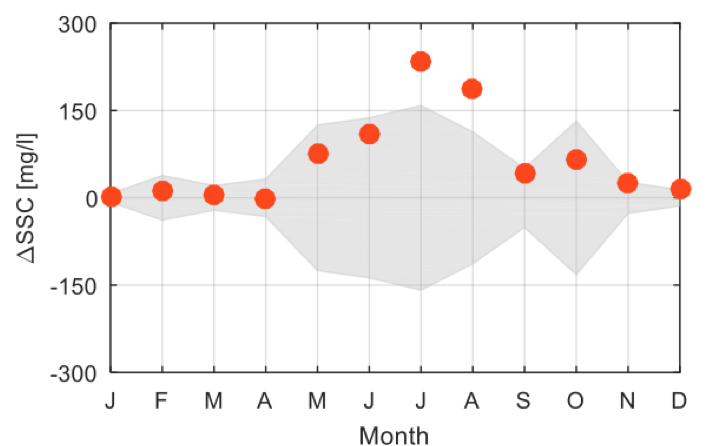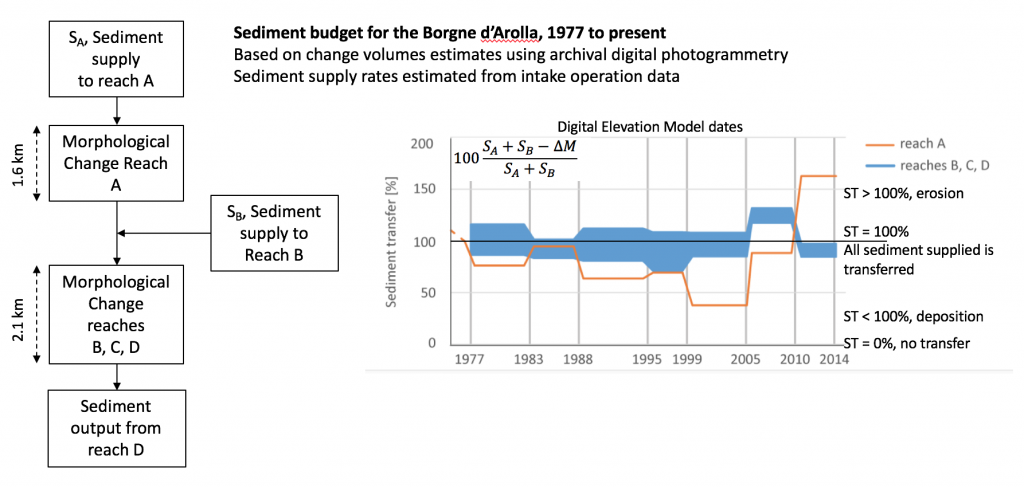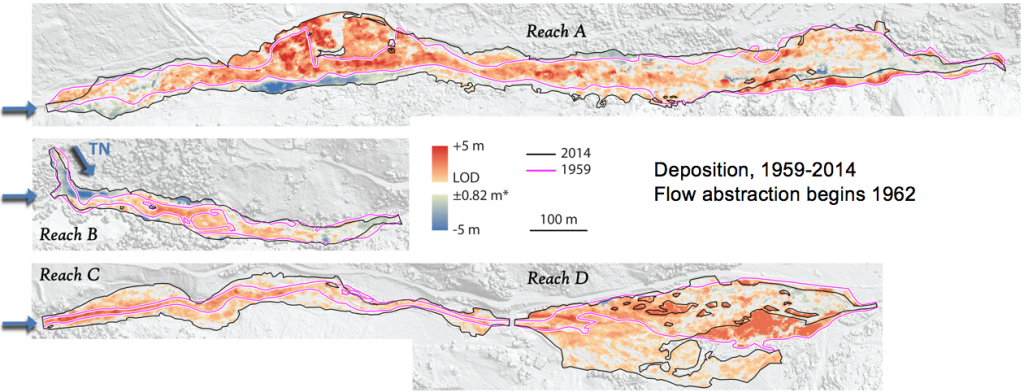UNIL staff: Maarten Bakker, Stuart Lane
SEDFATE was a 4 year project (2014-2018) that quantified changes in sediment flux in the Swiss Rhône basin, in the central European Alps, during the late Anthropocene to answer
- what are the precise timings, amplitudes and patterns of change in sediment flux, if any?;
- where are the sources responsible for the change?; and
- what are the mechanisms responsible for change, including the role of human activities in this context?
These questions were addressed through four subprojects, involving a collaboration between the Universities of Geneva, Lausanne and Berne and the ETH at Zürich:
A (lead, UniGE) focused on the quantification of the pattern of sediment flux to Lake Geneva within a detailed chronological framework for the past ca. 100 years;
B (lead, UniBE) identified the relative sources of sediment in selected sub-basins of the Rhône River using dating and provenance tracing techniques;
C (lead, UniLA) assessed the effects of primary (water abstraction, sluicing and flushing) and secondary (climate change) human impacts on the sediment production, sorting and redistribution downstream in the system; and
D (lead, ETHZ) applied a physically-based basin-scale model to upscale work C to consider flow regulation and sediment flux in the entire Rhône basin and its main river course.
There were 4 key findings
First, On the basis of carefully-designed sampling of sediment cores, higher rates of sediment supply to Lake Geneva (D) and rapid sedimentation rates in Lake Geneva (A) correlate with climatically warmer periods suggesting that, and contrary to what was expected, even in a very heavily modified river basin climate change signals may propagate through to the depositional record.
Second, this climate signal relates predominantly to the effects of climate warming on the release of sub-glacially stored material, confirmed through sediment fingerprinting (B), analysis of hydropower company records combined with reach-scale hydraulic modelling (C) and by basin scale statistical modelling (D) (e.g. Figure 1).

Figure 1. Changes in suspended sediment concentration close to the mouth of the Swiss Rhône showing a statistically significant increase in sediment concentration since the mid 1980s, but primarily in summer months. Further research showed that this was due to greater rates of ice melt during a period of rapid climate warming (Costa et al., 2018).
Third, human impacts, notably associated with hydropower do not necessarily disconnect sediment flux from source areas to downstream (C) but they may increase the sensitivity of sediment flux to climate variability and climate warming, but also to slight changes in how hydropower is managed (C, Figure 2), with consequences that can be detected in sediment provenance (B), measured sediment flux (D) and the size of fine sediment deposited in Lake Geneva with increase in size over the last 20 years attributed to the changing water management regime (A). These conclusions appear to hold more strongly for sediment transported in suspension than they do for bed sediment transport (D).

Figure 2. Volumes of sediment flux through an upstream series of reaches, A through D, reconstructed from archival digital photogrammetry and intake operation data (Bakker et al., 2018). Reach A has become a net sediment sink due to water abstraction for hydropower (that maintains sediment flux) but there is still substantial downstream flux of sediment (sediment transfer does not return to zero).
Fourth, in addition to these substantive scientific findings, the project made a number of important but more specific methodological developments, including: questioning the use of Be for estimation of denudation rates associated with glacial erosion (B); the development of a new provenance proxy (B); archival image analysis for reconstructing long-term sediment budgets (C Figure 3); influence of spatial patterns of bedload transport using application of the two-dimensional form of the Exner equation (C); new rating curve and conceptual models for predicting fine and coarse sediment flux through large and complex basins under both climate and human forcing (D).

Figure 3. Erosion and deposition in the Borgne d’Arolla between 1959 (before the onset of hydropower activities) and 2014, reconstructed using archival digital photogrammetry (Bakker and Lane, 2017)
Published project results from the entire SEDATE project (copies can be provided upon request to stuart.lane@unil.ch)
Antoniazza, G., Bakker, M. and Lane, S.N., in review. Revisiting the morphological method in two-dimensions to quantify bed material transport in braided rivers. Submitted to Earth Surface Processes and Landforms.
Costa A., Molnar P., Schmitt R.J.P., Burlando,P., (in review) Flow Regulation in Alpine Rivers: a Network-Based Model to Investigate the Impacts on Bedload and Grain Size Distribution, Water Resources Research
Silva, T.A., Girardclos, S., Stutenbecker, L, Bakker, M., Costa, A., Schlunegger, F., Lane, S.N., Molnar, P., and Loizeau, J.-L., (in review) The sediment budget and dynamics of a delta-canyon-lobe system over the Anthropocene timescale: the Rhône River delta, lake Geneva, Sedimentology.
Stutenbecker, L., Costa, A., Bakker, M., Anghileri, D., Molnar, P., Lane, S.,N and Schlunegger, F., (submitted). Disentangling the influence of human impact from natural controls of the sediment dynamics of an Alpine catchment. In review at Earth Surface Processes and Landforms
